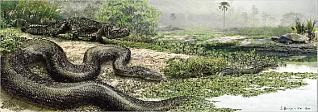| Typical Anaconda |
Anacondas usually spend the majority of their life near rivers to hunt their food. And these snakes don't just cozy up to people on a regular basis. They are actually rather shy and solitary. They are very well camouflaged to their environment in the South American swamps and bogs in which they thrive. Over time, there have been reports of anacondas that exceed the recorded length of 28 feet, some even reported to be 100 feet according to early European explorers, but their claims are taken with a grain of salt. It is believed that they may have found a snake skin that can stretch to monuments lengths. Also, snakes with larger sizes are more likely to be improperly measured. The larger they are, the greater possibility of error.
 |
| Titanboa |
It is a common misconception to believe that anacondas are venomous. They actually belong to the constrictor family and are non venomous. They are likely to dig into aquatic animals such as fish, but do feast on other snakes, deer, and even the occasional jaguar. These are slow giants, so they rely on strength and the element of surprise to feast. And you can't own one! I get asked this question more times than one may think. Unless you are a zoo keeper, your more likely to fly to the moon than own one of these guys.
But remember, it's not size that matters, it's how you use it.
Link: http://www.extremescience.com/biggest-snake.htm
No comments:
Post a Comment